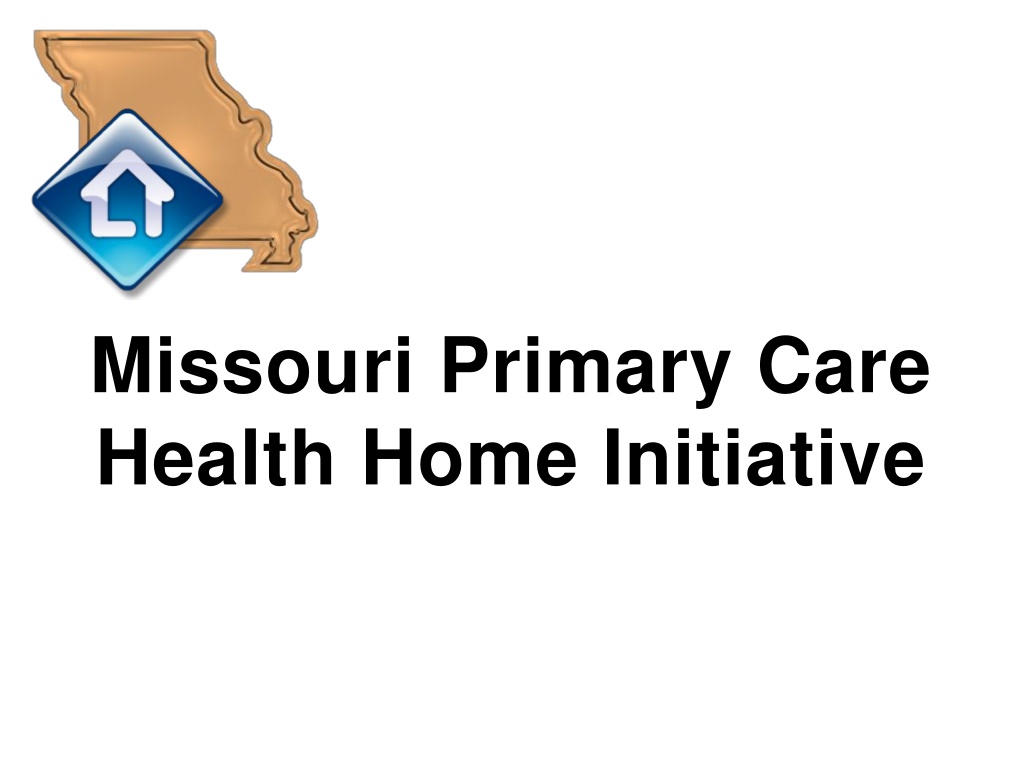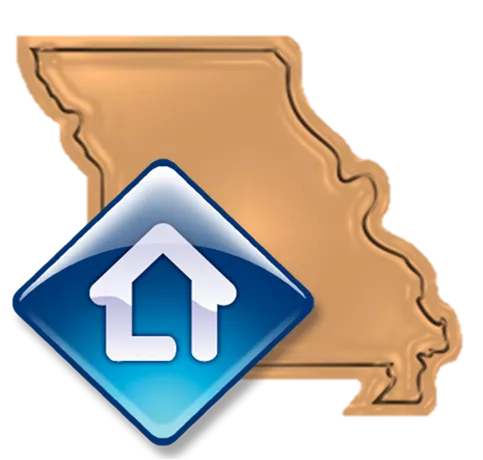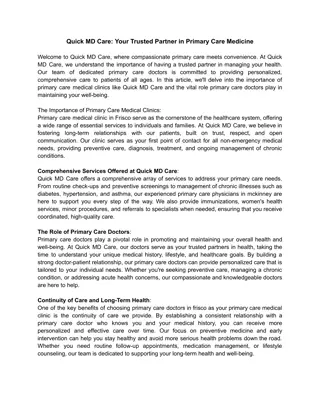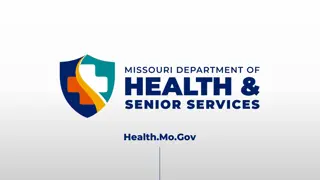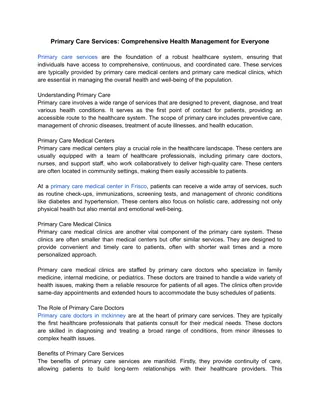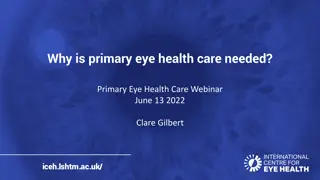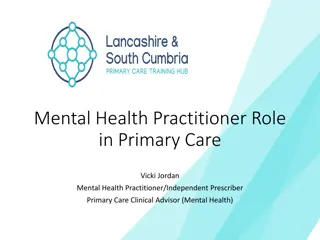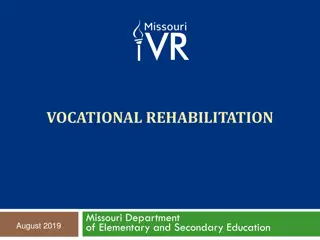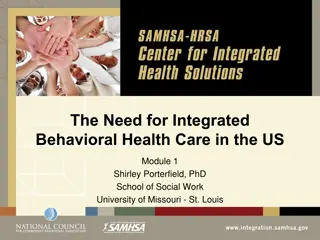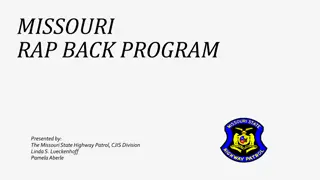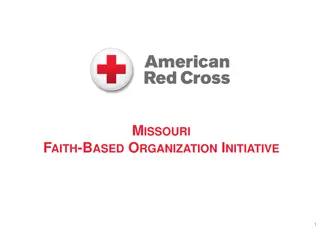Missouri Primary Care Health Home Initiative
Missouri Primary Care Health Home Initiative focuses on providing comprehensive and coordinated care to individuals with chronic conditions through a patient-centered approach. It incorporates both medical and behavioral health services, promoting education, activation, and empowerment for patients. The initiative leverages Section 2703 of the Affordable Care Act to offer Health Home Services for Medicaid enrollees with qualifying chronic illnesses. Missouri's Health Homes program includes two initiatives - Primary Care Behavioral Health and CMHC Healthcare Homes. Qualifying conditions under the Missouri PCHH program include diabetes, heart disease, asthma, overweight, tobacco use, and developmental disabilities.
Uploaded on Sep 27, 2024 | 3 Views
Download Presentation

Please find below an Image/Link to download the presentation.
The content on the website is provided AS IS for your information and personal use only. It may not be sold, licensed, or shared on other websites without obtaining consent from the author.If you encounter any issues during the download, it is possible that the publisher has removed the file from their server.
You are allowed to download the files provided on this website for personal or commercial use, subject to the condition that they are used lawfully. All files are the property of their respective owners.
The content on the website is provided AS IS for your information and personal use only. It may not be sold, licensed, or shared on other websites without obtaining consent from the author.
E N D
Presentation Transcript
Missouri Primary Care Health Home Initiative
Agenda What is a Primary Care Health/Medical Home? Overview of Missouri Primary Care Health Home Initiative FAQs and Rules of Thumb Data Collection and Reporting NCQA/PCMH Recognition Training and Technical Assistance
What is a Medical Home? Medical Homes Provide: comprehensive and coordinated care in the context of individual, cultural, and community needs Medical, behavioral, and related social service needs and supports are coordinated and provided by provider and/or arranged emphasize education, activation, and empowerment through interpersonal interactions and system-level protocols at the center of the medical home are the patients and their relationship with their primary care team
Section 2703 of the Affordable Care Act Section 2703 of the Affordable Care Act allows states to amend their Medicaid state plans to provide Health Home Services for enrollees with qualifying chronic conditions. States are eligible for an enhanced federal match for eight quarters (Missouri s ended December 31, 2013) Missouri approved in 2011 for two Medicaid State Plan Amendments to be able to provide Health Home Services to Missourians who are Medicaid eligible participants with chronic illnesses.
Missouris Health Homes Two health home initiatives in Missouri Primary Care Behavioral Health Similarities and Differences PCHH incorporates behavioral health care into the traditional primary care model through the addition of a behavioral health consultant (more on the BHC later) CMHC healthcare homes incorporate primary care into the traditional behavioral health model through the addition of nurse care managers and primary care physician consultants (they don t provide primary care, but do provide care management/care coordination for both mental and physical health for their participants)
Missouri PCHH Original Qualifying Conditions Combination of Two Diabetes (CMS approved to stand alone as one chronic disease and risk for second) Heart Disease, including hypertension, dyslipidemia, and CHF Asthma Overweight (BMI 25 or 85thpercentile) Tobacco Use Developmental Disabilities
Missouri PCHH Updated Qualifying Conditions New as of October 1, 2016 Behavioral Health Conditions (only one of these) Anxiety Depression Substance Use Disorder* Pediatric Asthma** Obesity (BMI 30 or 95thpercentile)** *must have at least one provider certified to provide medication-assisted treatment **stand-alone conditions must meet certain criteria
Participating Sites Initial participating sites: 18 FQHCs and 6 Hospital Affiliated Providers Expansion during the Spring 2014 legislative session Expansion during the Spring 2016 legislative session Current Participating Organizations: 25 FQHCs (two have delayed implementation) 11Hospital Affiliated Providers 2 Clinics
Goals of the Primary Care Health Home Initiative Reduce inpatient hospitalization, readmissions and inappropriate emergency room visits Improve coordination and transitions of care Improve clinical indicators ( e.g. A1C, LDL, blood pressure) Implement and evaluate the Health Home model as a way to achieve accessible, high quality primary health care and behavioral health care; Demonstrate cost-effectiveness in order to justify and support the sustainability and spread of the model; and Support primary care and behavioral care practice sites by increasing available resources and improving care coordination to result in improved quality of clinician work life and patient outcomes.
Use of Health Information Technology to Link Services CyberAccess Demographics Procedures Electronic Health Records Performance Measures ProAct Medication Adherence Data Warehouse (DRVS) Clinical Information Diagnoses Medications Care Coordination Providers Labs Patient Portal
Reports Hospitalization and ER visit notifications High utilizers (reports and graphs) Possible PCHH enrollees Monthly enrollment/discharge list Payment rejects Staffing/payment comparisons Retrospective payments Periodic care coordination reports (e.g. HCBS, DD) Managed care participants
Health Home Services ( Touches ) Comprehensive care management Care coordination Health promotion Comprehensive transitional care including follow-up from inpatient, ER, other settings Patient and family support Referral to community and support services NOTE: Touches must be documented
Health Home Services: Comprehensive Care Management Identification of high-risk individuals and use of patient information in care management services; assessment of preliminary service needs; Care plan development, which will include patient goals, preferences and optimal clinical outcomes; Assignment by the care manager of health team roles and responsibilities; Development of treatment guidelines that establish clinical pathways for health teams to follow across risk levels or health conditions; Monitoring of individual and population health status and service use to determine adherence to or variance from treatment guidelines and; Development and dissemination of reports that indicate progress toward meeting outcomes for patient satisfaction, health status, service delivery and costs.
Health Home Services: Care Coordination Implementation of the individualized care plan (with active patient involvement) Appropriate linkages, referrals, coordination and follow- up to needed services and supports -- e.g. appointment scheduling facilitating and making referrals and follow-up monitoring participating in hospital discharge processes communicating with other providers and clients/family members.
Health Home Services: Health Promotion Providing health education specific to an individual s: chronic conditions development of self-management plans with the individual education regarding the age appropriate immunizations and screenings support for improving social networks and providing health promoting lifestyle interventions, including but not limited to, substance use prevention, smoking prevention and cessation, nutritional counseling, obesity reduction and prevention and increasing physical activity. Health promotion services also assist patients to participate in the implementation of their treatment plan with a strong emphasis on person-centered empowerment to understand and self-manage chronic health conditions. NOTE: Newsletters or other educational materials can be used if they are targeted to a person s specific conditions.
Health Home Services: Comprehensive Transitional Care Comprehensive transitional care including follow-up from inpatient and other settings Medication Reconciliation Member of the health home team provides care coordination services designed to streamline plans of care, reduce hospital admissions and interrupt patterns of frequent hospital emergency department use. The health home team member collaborates with physicians, nurses, social workers, discharge planners, pharmacists, and others to continue implementation of the treatment plan with a specific focus on increasing patients and family members ability to manage care and live safely in the community Shift the use of reactive care and treatment to proactive health promotion and self management.
Health Home Services: Patient and Family Support Advocating for individuals and families, assisting with obtaining and adhering to medications and other prescribed treatments. Health home team members are responsible for identifying resources for individuals to support them in attaining their highest level of health and functioning in their families and in the community For individuals with developmental disabilities the health team will refer to and coordinate with the approved developmental disabilities case management entity
Health Home Services: Referral to Community and Support Services Assistance to patients including but not limited to: obtaining and maintaining eligibility for healthcare disability benefits housing personal need and legal services For individuals with developmental disabilities the health home team will refer to and coordinate with the approved DD case management entity for this service. Incorporation of community health workers into PCHH (pilot project)
Payment Method Providers that meet the health home requirements will receive a Per-Member-Per-Month (PMPM) payment for performing health home services and activities ( touches ) Current PMPM rate is $63.72 Providers pay a small PMPM to MPCA to cover administrative costs associated with data management, training, technical and administrative support, and practice coaching
Enrollment Eligibility Participant must meet the following criteria: MO HealthNet eligible Not be locked into hospice Meet spend-down, and/or pay any premiums due Have paid/final claims (excluding original claims that were reversed/ voided) with an approved PC diagnosis in one of the first five positions on a claim. Have qualifying condition(s) Have at least $775 in spend (proxy one ER visit or hospitalization) If seen by more than one eligible health home provider the patient is attributed to the health home provider seen the most during the analysis period
Current Enrollment Process Determine eligible diagnoses and other criteria (e.g. patient has PCP at clinic/organization) Check eMOMED for current Medicaid eligibility and spend down status Check CyberAccess to determine whether person is already enrolled in a health home Prepare and submit enrollment forms Name form using Lastname, Firstname convention. Send only one type of form in an email Make sure each form is only sent one time Send forms to enrollment coordinator (info on form)
Care Team Admin IT RN Care Manager. Care Coordinator Patient Health Home Director RN BHC Specialist RN/LPN/MA Provider
Health Home Team Members Health Home Director (1:2500) Nurse Care Manager (1:250) Behavioral Health Consultant (1:750) Care Coordinator (1:750) Physician Champion __________________ Administration Information Technology
Health Home Director Provides leadership for the implementation and coordination of health home activities Coordinates activities of other health home staff Champions practice transformation based on health home principles Monitors health home performance and leads improvement efforts Training and technical assistance Data management and reporting
Nurse Care Manager Must be RN for PCHH Direct relationships with patients and coordination with primary care team, specialty care teams, and inpatient facilities. Develop care plans Utilize MHD health technology programs & initiatives (i.e., CyberAccess and ProAct) Monitor HIT tools & reports to identify gaps in care and needed services for enrollees Address medication alerts, hospital admissions/ discharges and ER visits - including medication reconciliation Identify and address high utilizers Monitor & report performance measures & outcomes
Behavioral Health Consultant Focus on managing a population of patients versus specialty care Support care team in identifying and behaviorally intervening with patients to improve their physical health condition Assist with high utilizers Behavioral supports to assist individuals in improving health status and managing chronic illnesses Assistance with medication adherence, treatment plan adherence, self management support/goal setting, and facilitate group classes Brief interventions for individuals with behavioral health problems (not long term hour long therapy sessions) Brief coaching sessions for SBIRT
Care Coordinator This role does not stipulate a specific licensure requirement as the nurse care manager however many health homes have found it helpful to have someone with clinical knowledge such as a LPN or MA in this role. Assist with referral tracking and feedback Assist with performance improvement and data management. Process enrollment/discharge/transfer forms Provide assistance with enabling services such as transportation, food, housing, etc. Reminding enrollees regarding keeping appointments, filling prescriptions, follow-up on self-management goals, etc. Requesting and sending medical records for care coordination
Physician Champion Serves in a leadership capacity promoting and implementing the health home and medical home model Creates the strategic vision and drives the investment necessary to create the needed PCMH infrastructure Participates in health home planning meetings and activities Participates in development and maintenance of health home program structure and policies Promotes health/medical home transformation to all physicians Works with physicians who resist changes resulting from transition to the health home/medical home model Review data showing results of health home implementation
FAQs and Rules of Thumb Weekly emails contain important information for people who work directly or indirectly with PCHH. Please read them. FAQ handout
Importance of Communication Communication with and between care team members Communication with patient/families Accurate patient contact information/Patients desired way to receive communication Verifying with patient their contact information Ask How can I reach you today What communication preference do you have Communication with hospitals, specialists, and community partners Electronic Communication sources Patient portal Email/secure messaging HIE
Medical Home Neighborhood Partnerships Hospital Partnership MOU Workflow to receive ER/IP discharge information Key contact person Electronic access State provides Daily ER/IP notification for PCHH enrollees Specialty Services Other Community Resources Health Department Family and Community Trust (Caring Communities)
Stakeholder Role/Responsibilities Missouri Primary Care Association (MPCA) Project Owner, receives reports Support staff at FQHCs & PCCs when needed for questions around reporting and data accuracy Federally Qualified Health Centers (FQHC s) Transmit clinical data through DRVS connector Primary Care Clinics (PCC s) Transmit clinical data through flat file upload Azara Healthcare Provide access to DRVS reporting tool and maintains measures in the tool. Assist PCCs in flat file submission MO HealthNet Receives reports Missouri Institute of Mental Health (MIMH) Conducts evaluation of PCHH program Assists PCCs with data validation as needed in partnership with MPCA and Azara.
Data Flow Process MPCA sends all reports to MO HealthNet for FQHCs & PCCs each month MPCA CMS MPCA has direct access to all reports EHR & PMS Connected to data warehouse (pulls data nightly) Azara data warehouse FQHCs CMS reporting from MO HealthNet List of PCHH Enrollees transferred to warehouse on a monthly basis FQHC have direct access to reporting tool to pull its own reports Directly Connected PCCs PCCs have direct access to reporting tool to pull its own reports. MO PCC monthly uploads flat file to Azara warehouse HealthNet Standard PCCs
FQHC Technical Overview FQHC s are directly connected to DRVS Nightly data refresh PC-SPA is one of many reports available in DRVS. PCHH Enrollee & Medicaid Filters allows users to filter reports & measures to relevant populations. Azara handles all data extraction and submission. Data issues can be handled via our dedicated support team: support@azarahealthcare.com 36 Azara Proprietary & Confidential
Non-FQHC Technical Overview Data submitted monthly utilizing flat files via a secure server Data from all Medicaid patients seen at the participating primary care locations should be submitted with monthly data. Technical specifications are supplied and must be utilized in order for data to report properly. 37 Azara Proprietary & Confidential
Performance Goals and Measures Care Coordination Behavioral Health and Substance Abuse Screening and Use Chronic Disease Management: Diabetes, Cardiovascular disease, Asthma Preventative Health: Weight Assessment and Follow-up for Children and Adults, Population Health LDL Control Whenever possible national measure definitions were utilized from the National Quality Forum, Healthy People 2020, Meaningful Use, HEDIS, etc. to assist with alignment across programs.
Primary Care Health Home Performance Measures 1. Adult LDL < 100 6. Adult Diabetes A1c < 8 (NQF 0059 modified) 2. Adult Hypertension Controlling High Blood Pressure (NQF 0018) 7. Adult Diabetes BP < 140/90 (NQF 0059 modified) 8. Adult Diabetes LDL Management - LDL < 100(NQF 0064) 3. Childhood Weight Screening and Counseling 1. Child Weight Screening / BMI (NQF 0024) 9. Screening for Clinical Depression and Follow- Up Plan (NQF 0418) 10. Adult BMI Screening and Follow-up (NQF 0421) 2. Child Weight Screening / Nutritional Counseling (NQF 0024) 11. Care Coordination (MPCA PCHH) 3. Child Weight Screening / Physical Activity (NQF 0024) 12. Adult SBIRT Drug Use (MPCA PCHH) 13. Adult SBIRT Excessive Drinking (MPCA PCHH) Pediatric and Adult Asthma Controller Medication: 4. 14. Adult SBIRT Substance Abuse Screening and Follow Up (MPCA PCHH) 1. Use of Appropriate Medications for Asthma Ages 5-11 (NQF 0036) 2. Use of Appropriate Medications for Asthma Ages 12-18 (NQF 0036) 3. Use of Appropriate Medications for Asthma Ages 19-50 (NQF 0036) 4. Use of Appropriate Medications for Asthma Ages 51-64 (NQF 0036) 5. Adult Diabetes A1c > 9 (NQF 0059)
EHR & PMS Data Collection Many measures require data elements typically captured by your EHR system (labs, vitals, diagnosis) 10 measures/components discussed may require building of new templates and/or enhancing existing templates to collect necessary data elements All data elements must be captured in structured fields This allows for reports to be generated from the system Measure definition and data specification documents are available to provide for further guidance regarding required elements for each measure
Structured vs. Unstructured Data There is tremendous value in recording data using a common vocabulary and methodology. Creates data which can be recognized, ordered, analyzed, reported & shared. Data not captured in structured fields is not reportable UNSTRUCTURED DATA STRUCTURED DATA Radio buttons, Locked down Pick-lists, Checkboxes, NDC-ID (Meds), ICD-9/10/SNOMED(Dx), LOINC (Labs), CPT (Procedures) Dictation, Transcription, Voice recognition typing, Free text, Memo fields . 41
Key Components PCHH measures require qualifying encounter at least once per year so it is important to get PCHH patients that haven t been seen in last year you work with them to come in for a face to face planned visit. Review and Validate Workflow - Are all staff documenting according to your policies, processes and procedures? Required follow-up data elements documented in a structured field PCHH team needs to work with IT team to be sure structured documentation is mapped to DRVS or included in monthly data submission Notify MPCA Quality Coaches to allow notification of Azara prior to or shortly after to allow assessment of impact on flat file data submission for PCCs and DRVS mapping for FQHCs and directly connected PCC: Upgrade of EMR New or updated templates and documentation fields/locations Changes in Workflow
Care Coordination Requires two dates documented in structured fields: Date of discharge from inpatient or ER Date of Medication Reconciliation performed by Nurse Care Manager in person with patient or over the phone with patient with input from the PCP MOHealthNet supplies daily notification of ER visits and inpatient prior authorizations to assist with the care coordination measure
Childhood Weight Assessment and Counseling BMI measure requires BMI percentile, Height, and Weight due to the measure following the Meaningful Use Measure Specification Date of Nutrition Counseling And Physical Activity Counseling for children must be documented in a structured field at least once per year regardless of the child s BMI. Generic Anticipatory guidance verbiage that does not specify nutrition/diet counseling AND physical activity counseling will not count for this measure
Depression Screening and Follow-up Utilize Age Appropriate Depression Screening Adolescents 12-17 years of age Adults 18 and older Screening tool score must be documented in structured field(s) All positive screenings must have documented follow-up in a structured field(s) What constitutes follow-up? PHQ2 PHQ9 Date of Follow-up for further assessment PHQ9 Date of Follow-up for further assessment Follow-up for further assessment could include referral to BHC or addressed by provider during visit
SBIRT Screening and Follow-up Screening tool score must be documented in structured field(s) All positive screenings must have the date of documented follow-up in a structured field(s) Follow-up for further assessment includes completion of ASSIST performed by trained staff member, brief education, and/or referral to BHC
SBIRT Prescreen Scoring Pre-screen is positive and World Health Organization ASSIST needs to be completed if: Question 1 score + Question 2 score + Question 3 score is a combined score of > = 4 OR Question 4 = Yes
BMI Ages 18-64 and >=65 Height and Weight need to be documented on each patient at least once per year. Without both height and weight documented the EMR will not calculate BMI. Height carries over for one year from encounter to encounter. Date of documented Follow-up is required for patients that are: Outside normal parameters Normal parameters Ages 18-64: 18.5-24.9 Ages 65 and older: 22-29.9 Be sure to capture the work of all staff members i.e. rooming nurse/MA, Nurse Care Manager, BHC, Provider, Dietitian related to BMI follow-up for underweight or overweight. Date of follow-up documented in structured fields commonly includes education/referral regarding nutrition, diet, physical activity, community programs/classes, and/or lifestyle changes that support weight management
Performance Measure Outreach Team of Quality Coaches from MPCA will provide: Assistance with quality, integrity, and validation on performance measures/components Monthly performance measure improvement correspondence, trend charts, areas for improvement Tracking of DRVS scorecard access or flat file submission utilizing usage reports in DRVS MPCA Quality Coaches are Super users of CMT ProAct tool and create medication adherence reports that are shared monthly with PCHH organizations to assist with population health management and strategy for outreach to high utilizers
